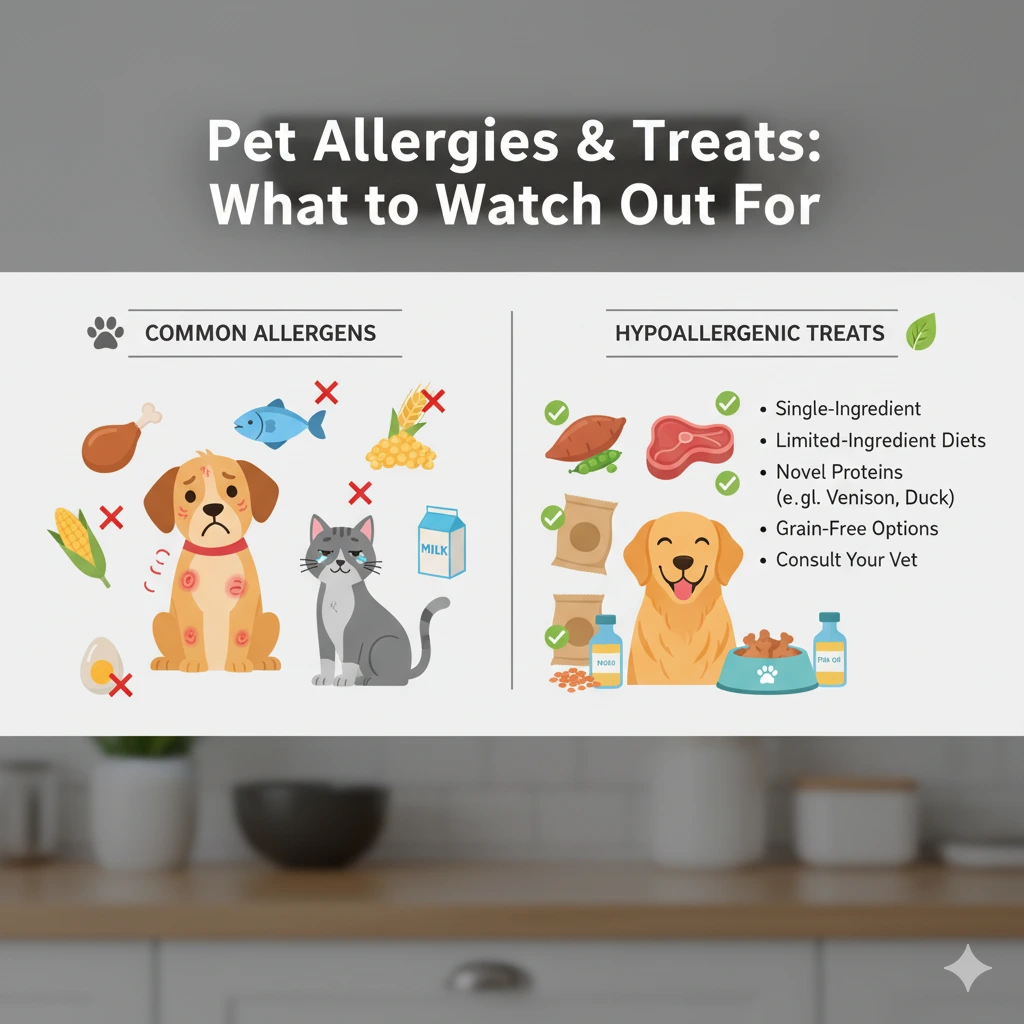If your furry friend starts scratching, sneezing, or licking their paws excessively after snack time, there’s a good chance they might be reacting to something in their treats. Just like humans, pets can develop food allergies and sensitivities, and one of the most overlooked culprits is often the treats we lovingly give them. In today’s world of endless pet snack options—from grain-free biscuits to organic chews—understanding what’s safe and what isn’t can make all the difference in your pet’s health and happiness.
In 2025, more pet parents are becoming conscious of pet nutrition, ingredient transparency, and allergen-free diets. Knowing what to look out for can help you choose treats that nourish your pet rather than trigger discomfort.
Understanding Pet Allergies
A pet allergy occurs when an animal’s immune system mistakes a harmless substance—such as a protein or grain—for a threat and mounts an immune response. This can lead to inflammation, itching, digestive upset, and other uncomfortable symptoms.
Food allergies in pets are often caused by prolonged exposure to certain ingredients. The immune system becomes hypersensitive over time, and the reaction can appear suddenly even after months or years of eating the same food.
The most common allergens in pet treats include proteins such as chicken, beef, dairy, and wheat, but additives and preservatives can also play a role. Understanding the difference between an allergy and an intolerance is key: allergies trigger immune reactions, while intolerances affect digestion without an immune response.
Common Symptoms of Food Allergies in Pets
Recognizing allergy symptoms early can prevent chronic discomfort and more serious health issues. Some of the most common signs include:
- Persistent scratching or licking, especially around paws, ears, or belly
- Red, inflamed skin or hot spots
- Recurrent ear infections
- Excessive shedding or dandruff
- Vomiting or diarrhea after eating
- Bloating or gas
- Changes in appetite or energy levels
If your pet exhibits any of these symptoms, it’s important to consult a veterinarian before making major diet changes. They may recommend an elimination diet or allergy testing to identify the exact trigger.
What’s in Treats That Can Cause Allergies
1. Protein Sources
Most pet food allergies are linked to animal proteins, especially chicken, beef, lamb, or fish. While these proteins are excellent sources of nutrition, repeated exposure can sensitize your pet’s immune system.
Hypoallergenic treats often use novel proteins—sources your pet hasn’t eaten before—such as duck, venison, kangaroo, or insect protein. These alternatives reduce the risk of triggering an allergic response and can still provide high-quality amino acids for muscle and immune health.
2. Grains and Gluten
Grains like wheat, corn, and soy are common fillers in mass-produced pet treats. While not all pets are sensitive to grains, some may develop gluten intolerance or grain allergies that lead to itching, ear infections, or digestive distress.
Switching to grain-free treats made with sweet potatoes, chickpeas, or oats can help alleviate symptoms. However, balance is key—grain-free doesn’t always mean healthier, and some recipes may compensate with excessive starch.
3. Artificial Additives and Preservatives
Many commercial treats contain artificial colors, flavors, and preservatives to enhance taste and extend shelf life. Ingredients like BHA, BHT, and artificial dyes can irritate sensitive systems and may contribute to allergic reactions or behavioral changes.
Look for natural preservatives such as mixed tocopherols (vitamin E) and rosemary extract. These are safer, antioxidant-rich alternatives that help maintain freshness without chemical additives.
4. Dairy and Eggs
Dairy ingredients like cheese or milk powder can cause lactose intolerance in dogs and cats, leading to bloating, gas, or diarrhea. Similarly, egg proteins can trigger immune responses in some pets. When in doubt, opt for dairy-free and egg-free recipes to avoid discomfort.
How to Identify and Manage Pet Allergies
1. Read Ingredient Labels Carefully
The simplest yet most powerful step is reading labels. Always check the ingredient list on pet treats—starting with the first few items, which make up the bulk of the product. Avoid vague labels like “meat meal” or “animal by-products,” as they often contain mixed proteins that can trigger allergies.
Look for single-ingredient treats made with pure proteins such as dehydrated duck, salmon, or sweet potato. The fewer ingredients, the easier it is to pinpoint potential allergens.
2. Conduct an Elimination Diet
If you suspect your pet has an allergy, your vet may suggest an elimination diet. This involves removing all potential allergens from your pet’s diet and reintroducing them one by one while monitoring symptoms. It’s a systematic and effective way to identify the culprit without unnecessary medications.
3. Opt for Hypoallergenic or Limited-Ingredient Treats
Hypoallergenic treats are designed to minimize allergic reactions by using novel proteins and limited ingredients. Brands specializing in these products often test for contaminants and ensure cross-contamination is avoided during production.
Limited-ingredient diets (LID) simplify the ingredient list, making it easier for pet parents to identify what their pets are reacting to. Many high-quality LID treats are also enriched with beneficial nutrients like omega-3 fatty acids for skin health.
4. DIY Treats for Allergic Pets
For ultimate control and peace of mind, consider making DIY pet treats at home. Using safe, vet-approved ingredients allows you to avoid allergens and preservatives entirely. Popular hypoallergenic ingredients include pumpkin, oats, blueberries, coconut oil, and turkey.
Homemade treats can be tailored to your pet’s needs, but always check ingredient safety—some foods safe for humans (like onions, grapes, or xylitol) are toxic to pets.
Natural Alternatives and Functional Ingredients
Pet owners are increasingly turning to functional treats that do more than just taste good. Natural ingredients like turmeric, salmon oil, and probiotics support skin and digestive health, helping pets recover from allergies naturally.
Treats fortified with omega-3 and omega-6 fatty acids can reduce inflammation, while those containing collagen or biotin support coat repair. Adding small amounts of these functional ingredients to your pet’s diet can make a noticeable difference in allergy management.
When to See a Veterinarian
While dietary changes can help, persistent allergy symptoms should never be ignored. Chronic scratching, recurrent infections, or digestive distress could indicate a deeper issue such as environmental allergies, flea dermatitis, or autoimmune disorders.
A vet can conduct blood tests, skin scrapes, and food trials to determine the exact cause. They might also recommend supplements, medicated shampoos, or prescription diets to restore balance.
Pet Allergy Myths to Avoid
- Myth: Grain-free means allergy-free.
Truth: Pets can be allergic to proteins or other ingredients, not just grains. - Myth: Allergies are only caused by food.
Truth: Pollen, dust mites, and fleas can also trigger reactions. - Myth: Homemade treats are always safer.
Truth: Homemade treats are great if made correctly—but using unsafe ingredients or poor storage can cause harm.
Understanding facts versus myths helps you make informed decisions that protect your pet’s long-term health.
Conclusion
Pet allergies can be frustrating for both owners and pets, but the solution often starts with a closer look at what’s in their treats. Knowing which ingredients to avoid—and how to identify safe, hypoallergenic options—can prevent flare-ups and promote comfort.
Whether you choose limited-ingredient commercial treats or DIY recipes, always prioritize transparency, simplicity, and quality. Watch how your pet reacts, keep track of symptoms, and work closely with your veterinarian for personalized advice.
At the end of the day, treats should bring joy—not discomfort. With awareness and care, you can make snack time safe, nutritious, and tail-waggingly fun for your beloved companion.



